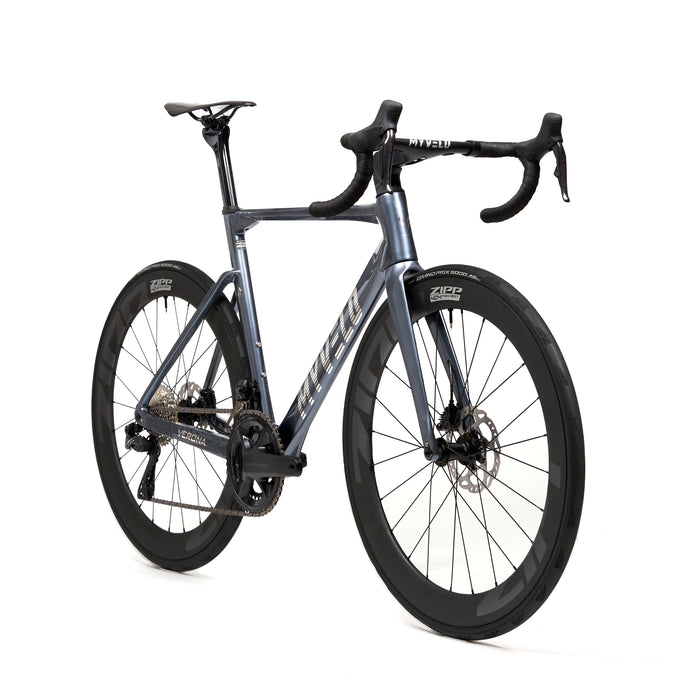
Verona road bike
incl. FREE shipping & free returns

Improving your cycling performance is a combination of endurance training, high-intensity intervals and strategic recovery. Two of the most important terms to understand are lactate threshold and steady-state training . Both are crucial if you want to ride faster, longer and more efficiently in the long term.
Von Lukas Vogt |
4 minutes read time

In this article, you will learn what the lactate threshold and steady state mean exactly, how to incorporate both concepts into your training, and why combining them can take you to a higher level on the road bike.
The lactate threshold is an essential point in performance diagnostics. It marks the transition from the predominantly aerobic energy metabolism, in which your body burns fat and carbohydrates with the help of oxygen, to the anaerobic range. In this anaerobic range, the body produces increased amounts of lactate, a byproduct of anaerobic metabolism. Lactate is not bad per se, but if more of it is produced than the body can break down, it leads to fatigue and the familiar "burning" sensation in the muscles.
The closer you can ride to your lactate threshold without too much lactate building up, the longer you can sustain high intensities before tiring. An important aspect of training is therefore to raise your lactate threshold in order to be able to perform better over longer periods of time.

Steady-state training involves riding at a consistent, moderate intensity - typically below your lactate threshold. Your body is in a state of equilibrium where the energy you need is mostly produced aerobically. In this state, you can ride for hours without experiencing any significant buildup of lactate.
Steady state is the perfect training zone for long endurance sessions because it improves your aerobic capacity, i.e. your body's ability to efficiently use oxygen and use fats as an energy source.
The two concepts are interrelated and are essential to maximizing your performance on the road bike. On the one hand, steady-state training helps you lay a solid foundation for longer endurance rides. On the other hand, the lactate threshold is the area that sets you apart on more intensive routes, climbs or in races.
By training both your aerobic endurance and your ability to process lactate efficiently, you can ride at higher intensities for longer periods of time without premature fatigue.
Steady-state training forms the foundation of your fitness on the road bike. In this phase, it's not about riding at maximum intensity, but rather maintaining a moderate load continuously. This makes your cardiovascular system more efficient, your muscles learn to use energy more evenly, and you improve your ability to cover long distances.
A typical example of a steady-state session would be a two to four hour ride at a constant, moderate effort. You should always stay below your lactate threshold so that your body works predominantly in the aerobic range. You burn fat as your main energy source and improve your ability to use oxygen.
Benefits of steady-state training:
In order to raise your lactate threshold , specific forms of training are required that challenge your body to perform better before it switches to the anaerobic range. Interval training is particularly effective as it regularly pushes you beyond the lactate threshold and helps your body to deal better with lactate formation.
A possible interval training to improve the lactate threshold could look like this:
This training aims to get your body to the point where it can break down lactate more efficiently and produce more power before fatigue.
The question often arises whether steady-state training or interval training is the better method to improve cycling performance. In fact, it depends a lot on your goals and your level of training. While steady-state training strengthens your basic endurance and improves your aerobic capacity, interval training ensures that you perform better on more intense routes and increases your lactate threshold.
Both forms of training have their place, and the most effective strategy is often to incorporate a mix of both into your training plan. This way, you can reap the benefits of both steady-state endurance training and intense, performance-enhancing intervals.
To get the most out of your training, good planning is crucial. Here are some helpful tips:
The combination of steady-state training and working on your lactate threshold is the key to continuously improving your cycling performance. While steady-state training helps you to ride efficiently over longer periods of time, training above the lactate threshold ensures that you can better handle more intense exertion.
The best option is a balanced mix of both training methods. Longer rides in the steady state range form the basis for your fitness, while interval training increases the intensity and raises your lactate threshold. This makes you stronger and more enduring both in long endurance sessions and in intensive, short sprints.
With a well-structured plan and the right balance, you will take your performance on the road bike to a new level - not just for short distances, but also for long distances.

Als Rennradfahrer möchte man möglichst ständig besser werden: schneller, ausdauernder und effizienter. Doch was, wenn der Schlüssel zu diesen Zielen nicht nur auf zwei Rädern liegt? Rudern, oft unterschätzt, bietet eine ideale Ergänzung zum Radtraining. Es trainiert nicht nur den ganzen Körper, sondern verbessert auch die Ausdauer, Kraft und Stabilität – entscheidende Faktoren für jeden Radsportler.

Nach einer intensiven Rennrad-Einheit ist die richtige Regeneration entscheidend, um Leistung zu verbessern, Verletzungen zu vermeiden und langfristig Fortschritte zu erzielen. Doch wie sieht eine effektive Erholung aus? Hier bekommst Du die besten Tipps zur optimalen Regeneration nach dem Rennradtraining.

Erfahre, wie Radsport-Ligen aufgebaut sind und weitere Infos zur Organisation im Profi-Radsport!